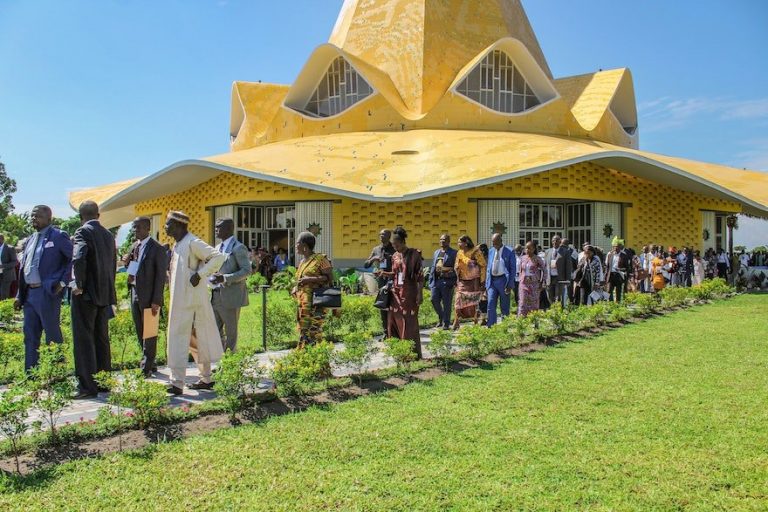
[ad_1]

KAMPALA, Uganda — On Sunday, in the country with Africa’s largest Catholic population where many flocked to see Pope Francis earlier this year, a new temple opened in Kinshasa, the capital of the Democratic Republic of Congo (DRC).
It’s hoped that the Baha’i house of worship, which over 2,000 people from across the central African nation and around the world attended the official inauguration of, will be a “force for social betterment,” said Rachel Kakudji of the Baha’i Office of External Affairs there.
“The House of Worship is open to people of all backgrounds and stands for the inseparable principles of worship and selfless service to humanity,” she said in a statement on the faith’s site. It is only the third temple for the Baha’i faith on the African continent. It is the first national temple for any country.
Members of the religion in the DRC are reported to be growing slowly but steadily as in others, like neighboring Uganda and Rwanda. Official figures are hard to come by, but there’s said to be about 200,000 members of the monotheistic and universalist faith in DRC, according to Kakudji. A 2011 study published by Harvard’s Divinity School said that there were about 1 million Baha’is in Africa, with about 38,000 in Nigeria.
Uganda is home to the only continental temple and up to 30,000 followers, said Nancy Oloro Robarts, a member of the Continental board of Counsellors in Africa, based in Entebbe, Uganda. A local temple opened in Kenya in 2021. And while members of the Baha’i in Iran continue to face prosecution, believers in places such as Rwanda say they’re able to live freely.
Kakudji told ReligionUnplugged.com that the ceremony held to mark the DRC temple was a “really wonderful experience”.
“The choir was just magnificent,” she said. “The leaders of the different religious (groups)— Islam, Orthodox, Protestant, Catholic — were there. People that didn’t think we could come together to pray realize it is now possible and have a deeper of understanding of it.” She added that “the moment between each reading, the quietness, was a high spiritual level moment for everybody.”
The Baha’i faith was founded in 1844 by Baha’u’llah, or Mirza Husayn-‘Ali Nuri from Persia, present-day Iran. Baha’u’llah translates into “the glory of God” in Arabic. According to the Baha’i faith site, around 1890-1950, Bab, the herald of the religion, declared that he had a message to transform humanity’s spiritual life. His mission was to prepare the way for the coming of a second messenger from God, but greater than himself, who would bring an age of peace and justice.
Between 1817 and 1892, Baha’u’llah — the promised one foretold by the Bab and all of the divine messengers of the past brought a new revelation from God to humanity. His thousands of books, letters and verses set out a path for the development of a global civilization considering both the spiritual and material dimensions of human life. This earned him four decades of jail, torture and exile.
Baha’u’llah appointed his oldest son, ‘Abdu’l-Baha, as the authorized interpreter of his teachings and as the faith’s head. Across the East and West, between 1814 and 1921, Abdu’l-Baha became known for promoting peace, as a role model for humans, and as the top proponent of this new religion.
Between 1897 and 1957, Shoghi Effendi, the eldest grandson of Abdu’l-Baha, appointed the guardian of the Baha’i faith, spent 36 years systematically nurturing the development of the Baha’i community. It was hoped that it mirrored the diversity of the entire human race. The Universal House of Justice was formed in 1963. In his book of laws, Baha’u’llah instructed it to have a positive influence on the welfare of humankind, promote education, peace and global prosperity, and to cherish human honor and religion.
The faith has three actors — the individual, the community and institutions. Matters pass through its institutions for decision making. Each country has a National Spiritual Assembly, composed of nine members. Today, it has a presence in more than 100,000 locations in just about every country and territory of the globe.
English and Iranian Baha’i believers came to Uganda in 1951. They were hoping to introduce the faith there and in just over a year had more than 100 followers. They set about spreading the word across Africa. Six years later, the Mother Temple of Africa, or the Mashriqu’l-Adhkar, opened.
“They picked Uganda because I guess the faith was growing very fast in the continent in Uganda,” Robarts told ReligionUnplugged.com. The Baha’i Intercontinental Conference for Africa was held in Kampala the same year to celebrate this.
The Mother Temple sits on a hill at nearly 38 meters (125 feet) tall. It’s about 3 kilometers (2 miles) from Kampala. Many who come across it are visitors to Kampala, touring other sights.
The community in the DRC has been eagerly awaiting its temple, with many from Uganda travelling there for the ceremony.
“My own personal opinion is that when the population has really tried, when they’ve experienced a lot of hardship, you’re searching for answers,” Robarts said. “I think the DRC (Congo) is at that point where they’ve had so many things, so many challenges generally as a community nationally: war, eruption of volcanoes. All these strengthen the spiritual vitality of the community.”
[ad_2]